
Twelve years after his debut, Godzilla found himself riding an international wave of giant monster movies, Japanese or otherwise. The previous three films flooded Toho Studios with an admirable amount of cash and an (arguably) even larger amount of prestige. Rival studios began fielding their own monstrous challengers to Godzilla’s crown, but no one really cared about them yet. Why settle for second, third, or even fourth-best when the King of Monsters’ still going strong?
Hoping to cement their market dominance, Toho shook things up behind the scenes, turning director Ishiro Honda’s years of daikaiju movie-making experience towards creating new kaiju with familiar, and thus internationally marketable, names (like “Frankenstein“). Special effects director Eiji Tsuburaya, his work now in high demand, founded the production company that bears his name and set to work creating the next generation of fans through the then-new medium of television…and a little superhero show called Ultraman. You might’ve heard about it.
Then someone got a hot idea: resurrect King Kong and team him up with Mothra for a rollicking kaiju adventure on a (budget-conscious) South Sea island. Then something happened. I’ve heard too many stories to tell you the truth. A dispute erupted over the rights to Kong’s name. Or the rights were all secure and the major sticking point became a cost-effective foreign distribution strategy. Or maybe someone, somewhere, mentioned the idea the became King Kong Escapes.

Whatever the case, Shinichi Sekizawa (writer of the last four Godzilla movies) found and replaced every mention of “Kong” in this script with “Godzilla.” This leads to some…interesting moments in what’s already a very interesting film. Next to the previous six it sticks out like a black thumb with a heavy talon on the end, suitable for forking prey into its jaws.
It begins with a recognizably Sekizawaian hero: Ryota (Toru Watanabe), a man young enough to be identifiable to the target audience yet still old-fashioned enough to believe in things. Like the village psychic. Who tells Ryota his fisherman brother, Yata (Toru Ibuki), believed lost at sea, is still alive. (Or, as she puts it, “Not in the land of the dead.” Which you could take several ways…) Desperate to rescue his brother, Ryota tries desperately to attract official attention. But it’s 1966. Who’s going to take the word of kid (relaying the words of a psychic) seriously?
Fate intervenes when Ryota spots a flyer for a competitive dance-off in the office of…some news paper. It’s not important. Ryota’s focused on the dance-off’s grand prize: a sweet-looking sailboat. This is more than enough to set his toes tapping but – oh cruel and capricious fate – the dace-off’s already three days underway.

Growing up, watching this over and over again on steadily decaying VHS tape, I always wondered why Ryota went for that crazy dance competition idea in the first place. Come to find out it’s because scenes of him trying out reasonable ideas (like getting the Maritime Safety Agency or the media interested in his brother’s story) were cut from the American release of this picture so we could skip right to the dance party. Because that’s what the crazy kids of 1966 were all up into, am I right? What Vietnam War? What Civil Rights Movement?
Ryota hooks up with two failed contestants at the dance-off, Ichino (Chôtarô Tôgin, two years after his battle against Dagora, the Space Monster) and Nita (Hideo Sunazuka, who’d go on to star in the Frankenstein Meets the Wolf Man of fictional master swordsman films, Zatoichi Meets Yojimbo). On a lark, and figuring that if he can’t have a boat he can at least look at bunch of them and experience the Poor Person’s Remorse, our Three Musketeers drive down to the docks. They pick a boat at random and, to their surprise, find it stocked with enough provisions to last an oceanic crossing…and already occupied by its gun-wielding apparent-owner, Yoshimura (Akira “Ogata” Takarada in his fourth Godzilla film and the last one he’d appear in until 1992’s Godzilla vs. Mothra).
For reasons that escape me to this day, Yoshimura allows the Three Dance-Crazed Musketeers to spend the night. This gives Ryota more than enough time to set sail, justifying his Grand Theft Sailboat on religious grounds.
Ryota: I realized this was a gift from the gods.
Yoshimura: Turn the boat around!
Ryota: I can’t return a gift from the gods.
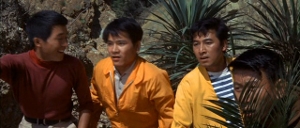
Why did Yoshimura let them stay in the first place? Simple politeness? If so, it’s another case of social obligation screwing up an already crazy plan. In Japanese fiction? Well, I never.
Why does Yoshimura go along with this once they’re out to sea? Because only Ryota knows how to sail. This, and the fact Yoshimura’s rifle turns out to be a toy, lead Our Youthful Heroes to believe there’s more to this pre-Jimmy Buffett beach bum than meets the eye. Yoshimura’s over-protection of his swanky big black briefcase and annoyance with radio reports of a daring one-man bank robbery confirm everyone’s suspicions. He laughs them off, like you do if you’re a serious criminal talking to marks, but if Yoshimura’s half the badass he thinks he is, he would’ve never wound up in this situation in the first place.
I mean, really. If Yoshimura had no previous sailing experience, why the hell was he hiding out on a sailboat? The problem with boats (wind or gas powered) is, if you leave them where you find them, their owners have a bad habit of coming back and demanding to know what the fuck you’re doing. Trespassing? Breaking and entering? Burglary?
Days pass as the Home Islands fall back below the horizon line. The perpetually seasick Ichino and Nita begin whispering mutiny. A freak storm puts a stop to such keelhaul-worthy talk. A giant claw (but not The Giant Claw, thankfully – that movie sucked) ends all debate by rising from the storm-swept ocean to sink Our Heroes’ boat.
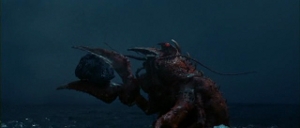
Hmm…freak storms, premature volcanic eruptions, fishing boats just disappearing…this all sounds terribly familiar. Are we still blaming the Xians and their magnetic waves for the fucked up weather this Earth’s endured over the last three Godzilla movies? Is it too early to start blaming the Space Cockroaches?
Washing up on a not-so-deserted island, Our Heroes take stock. Realizing the gods have thoroughly screwed him over, Yoshimura emerges as Our Heroes’ defacto leader by coming up with all the good ideas for a bit. Like circling the island until they find an ultra-modern looking dock and an even more technologically advanced base. Too bad it’s all guarded by armed thugs in the kind of post-colonial khaki uniforms dictators the world over have made so infamous.
With Yoshimura’s Criminal Senses tingling, Our Heroes observe the Khaki Club’s boat dock and disgorge a hold-full of prisoners. Several attempt to escape, with two making for the ocean and the outrigger canoe conveniently located just a few meters away from the dock. These unfortunates (Shôichi Hirose, the actor who played Kong in King Kong vs. Godzilla and Ghidorah in the last two films; and Kazuo Suzuki, who played an assassin in Ghidorah, the Three-Headed Monster and a background Xian in Godzilla vs. Monster Zero) are quickly gobbled up by the giant lobster just off shore, whom everyone on the docks seems to recognize as “Ebirah.”
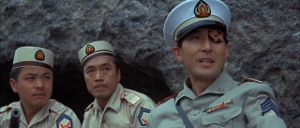
The eye-patch wearing Commander of the Khaki Club (Akihiko “Dr Serizawa” Hirata, rocking the eye-patch once again in this, his fourth Godzilla film and – by my count – eighth Toho kaiju movie overall) makes things plain for the new arrivals. “Even if you escape from us, you won’t escape from Ebirah!” The one escapee smart enough to run for the jungle, a young woman named Daiyo (Kumi “Miss Namikawa” Mizuno in her second Godzilla movie) fills the rest of the blanks after she (literally) runs into Our Heroes.
The Khaki Club call themselves The Red Bamboo, a ruthless terrorist organization no doubt determined to conquer the world. They’ve been raiding neighboring islands for some time now, forcing prisoners into a life of slave labor. Within their fortified compound, stereotypical natives toil, manufacturing a yellow liquid from the island’s local plant life that keeps Ebirah from attacking the Red Bamboo’s supply ships.
But that whole slave labor camp operation is nothing, relatively speaking. Just something to keep the supply lines open. (The gods only know what all those Red Bamboo redshirts would do if the island ever ran out of beer.) After gaining access through Yoshimura’s mad breaking and entering skills, Our Heroes quickly discover Red Bamboo’s plan to become a world nuclear power. They’ve already got the heavy water factory up and running.
Yoshimura: We’ll fight them with our brains instead of guns.
Nita: You sound like a stupid politician.
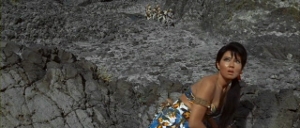
Really? Damn. Things really have devolved since 1966. These days, stupid politicians solve everything with guns.
Inevitably, the situation goes tits up. Yoshimura, Ichino and Daiyo escape into the seaside caves. Nita, being the closest thing to Odious Comic Relief on this island, gets himself captured and thrown into the dungeon. Ryota escapes the island completely via a hot air balloon that I’m sure should sink under his weight. Good thing Ryota’s got the mutant power to turn himself into a doll whenever the film cuts to a wide shot.
Through the power of narrative convenience (or “the gods” I guess) Ryota makes it all the way to Infant Island, home of Mothra, her pint-sized Shobijin…and Ryota’s long lost brother, Yata. Their reunion’s cut short once Ryota tells everyone where he’s come from. The Shobijin instantly recognize Red Bamboo and their island, which they’ve name “Devil’s Island” for fairly obvious reasons.
“The people who are taken never come back.”
And it’s easy to see why. Red Bamboo’s thorough search and recovery methods include stalking along in single-file lines, firing randomly into the foliage, and shouting as loudly as possible. Our trio of cave dwelling heroes easily avoid all that noise, but their position isn’t exactly what you’d call “secure.” For within their cave, Our Heroes discover the sleeping form of…Godzilla!

Bet those of you who don’t know this film like the back of your hand were wondering when he’d show up, eh? You can tell this was supposed to be a King Kong vehicle by its structure. Our human protagonists wind up in the South Pacific (“way out of any shipping lane”) thanks to a series of mad coincidences. Our Heroes wake Godzilla up with lightning, echoing Toho Kong’s fondness for electricity. Like Kong, Godzilla’s plagued by random encounters with Devil’s Island’s native monster population (Ebirah challenges him as soon as he wakes up and a giant condor swoops out of nowhere to try and peck his eyes out a little later on.) Like Kong, Godzilla kicks the shit out of a squadron of Red Bamboo fighter planes before going on to trample their compound.
That fight with the planes (and Red Bamboo has planes now? Who the hell’s financing this pack of jokers? SMERCH? SPECTRE? Lex Luthor?) reminded me why I bought all the Japanese versions of these movies. We poor Americans never knew that, in the original cut, Godzilla trashed those planes to the tune of some kickin’ Generic Surf Rock. Ya know…for the kids!
Too bad this was the first Godzilla film that did not enjoy a U.S. theatrical release. It really is the perfect Drive-in movie. If you start necking as soon as the dance party concludes, you and your date should be rounding home base just in time for the thirty-minute climax of (almost) pure monster action. Like a Kong film. But vs. The Sea Monster‘s structure also bears a marked resemblance to modern action films. The middle forty-five minutes are an extended chase sequence which blends itself organically into Godzilla plot.
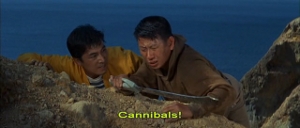
For the first time in the series, Our Human Heroes are not drawn from the Tarot Deck of Daikaiju Movie Stock Characters. By himself, Yoshimura represents a revolution in Japanese drama, which traditionally portrayed criminals as bumbling incompetents (the better to preserve their audience’s moral health, natch). (Witness the assholes who brought Godzilla down on Osaka in Godzilla Raids Again.) Throughout the narrative, his criminal skills are drafted in service of a higher calling, a Good Cause. He still ends up telling the others he’s reformed by the end of the flick – but then again, don’t they all?
Once they get to the island, the other characters become Yoshimura’s underwritten sidekicks, defined by the one trait their actors have the chance to express. Ryota’s obsessed with his brother. Nita makes comically surprised faces. Ichino complains. And Daiyo’s a native girl. Yet each one manages to contribute something, even in their truncated state, which is more than I can say for King Kong’s cast. Yoshimura runs out of ideas once their raid on the Red Bamboo compound goes south, leaving Ichino to suggest waking Godzilla up. Early on, Nita finds a sword, which he carries with him like a big shinny security blanket. As a weapon, it’s useless…but when combined with a necklace of coiled wire Daiyo grabbed out of Red Bamboo’s warehouse (cuz she’s a girl and girls the world over all love shopping, am I right?) it becomes the lightning rod that zaps this flick into overdrive.
Complimented by mystery and comedy director Jun Fukuda, who brings a (for lack of a better word) contemporary style to the franchise. No matter the film, Ishiro Honda Godzilla movies are all plagued by scenes where two or more characters stand around talking about the plot. There’s no time for that here. Once we finally get to Devil’s Island everyone’s too busy running around. Exposition’s given on the fly, the way modern film schools tell you it should be. How good is this movie’s pace? It makes us wait a full hour before delivering on the promise of Godzilla and I don’t mind one bit. The actors, their chemistry, and the performances Fukuda capture carry me through without breaking a sweat, especially now that I don’t have to put up with Titria Studios’ dubbing.
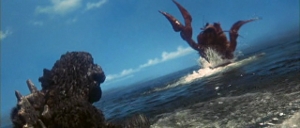
And then there are the monsters. Mothra looks a little worn but, as giant sea life goes, Ebirah’s a thing of beauty. I salute stuntman Yu Sekida for playing all his scenes waist-deep in a water tank. Same goes for your Godzilla and mine, Haruo Nakajima, who does his usual compliment of smashing on top of fighting the first sea-based battle in the series. Godzilla’s raid on the Red Bamboo base is effective despite its brevity because (for once) we know what the insides of these anonymous miniature buildings look like. We’ve just run around inside them we our main characters less than fifteen minutes ago. And much like Godzilla’s destruction of the Happy Enterprises camp three films ago, we get cathartic jollies from cheering Our Monstrous Hero on as he flattens some slave driving terrorists with nuclear ambitions.
It’s not a perfect film, but it’s not the “kiddie” movie its often dismissed as. There are some plot holes. There’s no visible entrance to Godzilla’s cave, so I have to wonder just how the hell he got in there in the first place. (And how he snuck past Ebirah on the way in). The opening gambit of Godzilla and Ebirah’s first battle consists of them playing catch with a boulder, our first peak at the effect Fukuda’s comedic past will have on this series as a whole. But it’s good cast, fast pace, and tight construction make up for all that.
While it’s far from my favorite Godzilla film – or even my favorite Godzilla film of the 1960s – Godzilla vs. The Sea Monster does manage to get better every time I see it. It’s a fun, fast, fluid monster movie with a distinct identity the next three Godzilla movies would try to copy. If that’s your bag (baby) then this movie has (almost) everything you need…except the alien invasions. But we’ll get back to those soon enough.
![]()
![]()
![]()
![]()
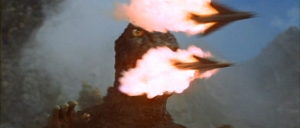

This was my first Godzilla movie (I had the Video Treasures VHS) and it’s one that I’ll defend until my dying day. I like that the dubbed version has the characters suggesting that Ichino would know all about the Red Bamboo’s lab because he “took a science class” and that (IIRC) a skeleton key could be used to a person enter a nuclear reactor.
A skeleton key made on a shaky boat by a random stick-up artist, no less. Better still – no matter what language you’re hearing – everyone recognizes the nuclear reactor on sight. I know the Japanese education makes ours look like a whiny, emo git but damn…I would’ve loved to attend a few of those science classes.
I too had the Video Treasures VHS. Found in the Wal-Mart bargain bin for $12 bucks. Hell, I called it a bargain after I’d run the tape to ribbons years later.
I believe my copy was bought in 1989 for 10 dollars at “Musicland” (before it became “Sam Goody”) and was still functioning quite fine before I moved to Brazil in late 2004 and left it behind. I need to get that on DVD.
Yes, you do. I knew Fukuda meant this movie was to be a bright, colorful romp…but damn, son, I didn’t know how mind-achingly gorgeous it could be until I got my DVD copy.
I got my copy by taping it off TV. During one of The Movie Channel’s periodic promotions where you’d get access for “Free” as part of your basic cable package, they had the Medved Brothers (whose conservative politics I was not aware of at the time) on to host a Godzilla marathon. My parents or older brother knew they were having the marathon, the VCR was programmed, and when I woke up I caught a few of the movies live, the rest I watched on tape. What a glorious day that was-this movie, Ghidra, the Three Headed Monster, Gigantis the Fire Monster, and, I *THINK*, Son of Godzilla.
That’s one hell of a haul. By the time my parents sprung for satellite nobody showed Gigantis or Ghidorah. Had to wait for the fortieth anniversary video release for the latter and didn’t see the former until it hit DVD. On the other hand, Ted Turner unwittingly brought Son, Monster Zero, Mothra vs., Terror of Mechagodzilla and King Kong Escapes into my house thanks to a TBS holiday marathon at some point int he mid-90s. This was before we had anything more than four channels…but my family dentist put me in contact with one of his then-teenage son’s friends, who’s family did have cable. He gave me four VHS tapes worth of kaiju. Tied up both VCRs in the house that day, I can tell you.
Ah, yes, the old trading and dubbing. I have fond memories of dubbing early 1990s, 1980s and late 1970s anime my friend traded for in my living room, with my mother occasionally coming in to ask “If it’s Japanese animation, why don’t the characters look Asian.” About five years earlier the tapes being dubbed would be rented from Videoland, and would have been Godzilla movies, and mom would merely chuckle at the special effects as she walked by. I think I got Terror of Mechagodzilla, among other things, that way.